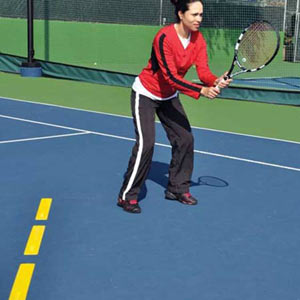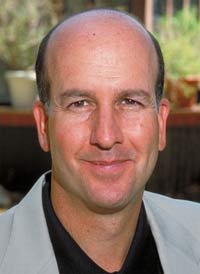|
TennisOne Lessons Sight, Sound, and Rhythm Training for Tennis Joe Dinoffer Sights and sounds are all around us. We grow and learn from them starting the day we are born. They not only teach us how to function; they also trigger us to take action. A few visual triggers are red stop signs, flashing police lights and seeing lightning that forewarns stormy weather. Common sound triggers include alarm clocks, police sirens, and beeping microwaves. What does this have to do with tennis? Take away hearing or good eyesight from a tennis player and things change drastically. The exercises in this article will guide you to explore your senses of sight and hearing, both fundamental human functions. You will learn that using different sights and sounds on a tennis court can trigger improvement. My broader hope is that after trying some of these exercises you will also become more aware of the sights and sounds that are a part of every aspect of your life. Here are some easy-to-implement examples of using sight to guide us to better tennis:
Cover the Net It always amazes me how few people realize that the net creates an illusion since we can see through it. Otherwise, how do you explain how many errors are made hitting balls into it? Next time you play a set, keep track of how many balls your opponent hits into the net and write it down on each changeover. Ideally you should also you keep track of your own shots, but by focusing on it, you will probably not hit as many as you normally would. So, if you have a friend you can practice with, keep track for each other. After all, there are two basic goals in tennis. Hit over the net and inside the lines! If you hit a ball over the net, immediately you have succeeded in accomplishing 50% of your basic objectives! What can you use to cover the net to see what it is really like? A bunch of towels or a sheet do just fine. Raise the Net
Of course, it’s not that we set out to hit into the net. Most net balls are a result of players not consciously hitting with enough arc. To practice visualizing your arc or net clearance, you need to either raise the height of the net, or hit over something that is taller than the net itself. If you have an umpire’s chair you can roll onto the court to aim over, this is an easy solution. The net can also be raised with any combination of sticks, telescoping poles, ropes, or bungees. If you have never hit over a raised net, it can change your on-court visual reference in a good way … forever. Angular Poaching We all know players should angle forwards when poaching in doubles. There are four benefits:
The problem is most players just don’t force themselves to angle forwards when they poach. This is evidenced by the fact that this is one of the most repeated instructions when tennis pros and coaches work with doubles teams! A physical visual guide as pictured in this article is a quick solution. Just lay down a rubber line, a towel, or a thin rope and practice moving across AND forwards when you poach.
Now let’s move to some easy-to-implement examples of using sound to improve: Hit and Split Timing the split step challenges many players. Forget to split altogether or split step too soon and you end up standing flat-footed. Split too late and you are in the air as the ball is crossing the net and will feel rushed against hard hitters. This exercise can help you time your split to occur at about the same time your opponent contacts the ball. (Please note that the precise timing of the split actually changes as players improve, but this is a good starting point for most.) It goes like this: Rally from baseline to baseline with a practice partner. Have your partner loudly call out “Hit” as he/she contacts the ball. When you take your split step, you loudly call out “Split.” Your goal is to call out “split” at the same time your partner calls out “hit.” Be forewarned, it may sound like “Sp … it” depending on who shouts the loudest.
Grunt Game Many top players audibly exhale when they hit. Not surprisingly, many recreational players therefore wonder if this is a habit they should adopt. The answer is that exhaling while you hit is clearly a good thing. It is recommended in all sports since muscles relax when we exhale. But there is a lot of variety out there, from screams in karate board-breaking exhibitions to the soft exhales of a pro golfer. This is commonly called “grunting” in tennis and it takes many forms: It can be soft with an almost pleasant rhythm to the listening audience, or it can be obnoxiously loud. It can also be mono-or multi-syllabic. Listen to this entertaining YouTube creation from the French Open as aired on the Jimmy Fallon show. https://www.youtube.com/watch?v=avSuLWPelW0. To figure out what resonates with you, just get on the court with a partner who really likes you and practice grunting at different volumes and see what feels right for you. And, whatever you decide, consistency is the key. The Hippie Drill If you’ve ever felt tight or nervous on a tennis court, you will find this exercise really helpful. We all know that gripping the racquet too tight is a major cause of problems, from short choppy swings to tension-created injuries. Here’s the exercise: Rally with a partner from baseline to baseline. After each shot you hit, take your racquet hand off your racquet, and support it with your non-racquet hand. Put your racquet hand on your hip and count to five. At first you may feel rushed, but as you get used to it, you will start to learn how to relax your racquet hand grip in between shots.
Hit-Bounce-Hit Let’s finish with a class sound-triggered exercise from Tim Gallwey’s best-selling book, “The Inner Game of Tennis.” It’s a very simple exercise called “bounce-hit” and goes like this. When you or your practice partner hit the ball you call out “hit” and when the ball bounces you call out “bounce.” Sounds easy, right? Try it and you’ll probably experience an increase in focus and improved rhythm. It’s a classic drill that is still effective years after it was first published in book form in 1972.
Your comments are welcome. Let us know what you think about Joe Dinoffer's article by emailing us here at TennisOne.
Joe Dinoffer is among 10 master professionals in both the USPTA and PTR. He was also awarded the USPTA National Industry Excellence Award as well as Texas Division Pro of the Year. He has written and produced 7 books and 22 DVDs and has appeared numerous times on the Tennis Channel. Joe is also the founder and President of Oncourt Offcourt, Ltd., a tennis company recognized as one of the most creative in the industry. See his work at www.OncourtOffcourt.com. |


 Joe Dinoffer
Joe Dinoffer